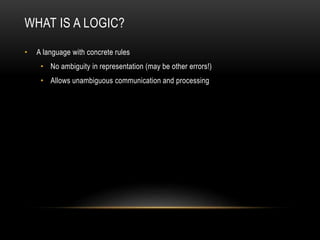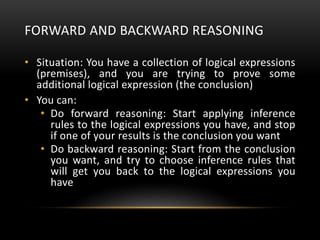- Propositional logic and predicate logic are discussed, including their syntax, semantics, and reasoning patterns.
- Unification and resolution are introduced as techniques for inference in logic. Unification allows making two atomic expressions identical through substitution, while resolution is a rule of inference that allows deducing new clauses from existing ones.
- Examples of first-order logic sentences are provided to illustrate predicates, quantifiers, and how unification can be used to deduce new facts from existing premises.





















![• 1. All birds fly.
• ∀x bird(x) →fly(x).
• 2. Every man respects his parent.
• ∀x man(x) → respects (x, parent).
• 3. Some boys play cricket.
• ∃x boys(x) → play(x, cricket).
• 4. Not all students like both Mathematics and Science.
• ¬∀ (x) [ student(x) → like(x, Mathematics) ∧ like(x, Science)].
• 5. Only one student failed in Mathematics.
• ∃(x) [ student(x) → failed (x, Mathematics) ∧∀ (y) [¬(x==y) ∧ student(y)
→ ¬failed (x, Mathematics)].](https://image.slidesharecdn.com/2-logic1-240409031323-7b0c51be/85/Logic-in-Predicate-and-Propositional-Logic-22-320.jpg)
























